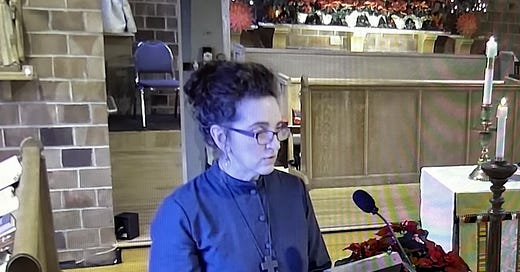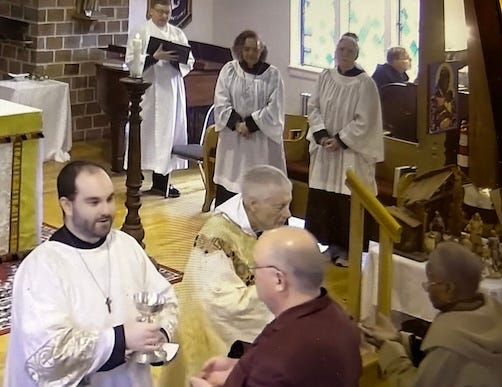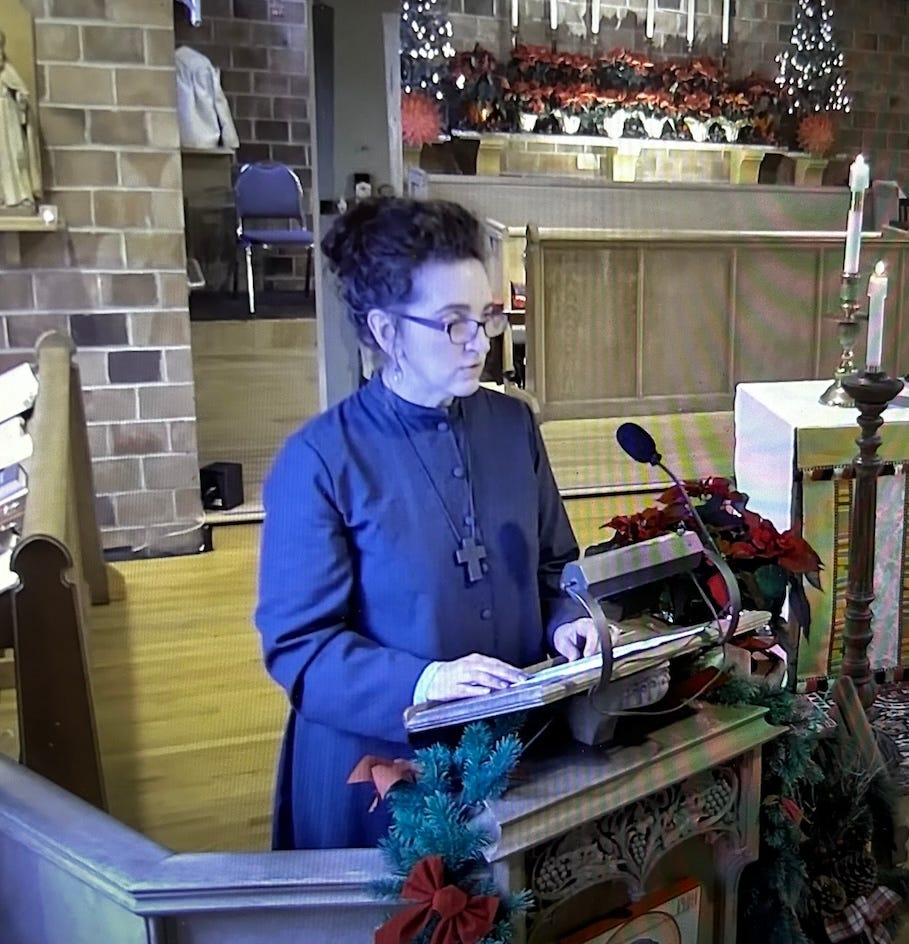Today Sister Michelle preached at St. Clement’s, Seattle. The text is below. Or you can watch it on YouTube — HERE at 27:00. Yes, that’s Brother Robert presiding. He was a last minute replacement for the rector who fell ill. That’s why it is said, not sung (a bit of mercy for the congregation), straight BCP with no enhancements (keeping it simple for the old priest). Sister Michelle engages the issue of antisemitism that we have written about before - here and here and here. Michelle speaks of a picture from 1931. You can see that picture in this New York Times article, “Lighting Hanukkah Candles Under the Swastika’s Shadow” or at this place in Google Images
This year, as you probably know, Hanukkah began on the first day of Christmas, and continues for eight days. It’s very rare that we have this Jewish holiday fall so closely with Christmas and it feels particularly poignant now. Part of the tradition of Hanukkah is to place the menorah, the candelabra that is lit for eight nights, in the front window of the house. The miracle of Hanukkah commemorates the Jewish people’s rededication, in 164 BCE, of their desecrated temple. Over the millennia since, placing a menorah in your window has been a way to symbolize Jewish perseverance in the face of overwhelming adversity and persecution. It’s also been a powerful statement about religious freedom. It peacefully declares that here, in this house, a Jewish family is persisting in the Jewish faith.
The menorah and the swastika
There’s a famous picture taken by Rachel Posner in 1931. I’ve put a copy in with your bulletin. She was a rabbi’s wife, living in a northern German city. They lived across the street from local Nazi party headquarters. It was Hanukkah, and the Posners had placed their menorah in their window. Beyond the menorah, you can see the swastika on a public building – a banner on a building in Germany eight years before Hitler invaded Poland. A swastika is probably the most recognizable symbol of evil we have. And the menorah in front of it is a courageous symbol of light that is not overcome by darkness.
Rabbi Meir Soloveichik recently wrote that Rachel’s picture symbolized not just what Jews have had to fight against, but, more important, what Judaism has stood for. He wrote that it was Judaism that first recognized “human beings are equal because they are created in the image of God, and that this is the only enduring foundation for human equality and life’s sanctity.” Rachel herself wrote on the back of the picture at the time she took it, “The flag says ‘ to Judaism,’ the light says ‘Judaism will live for ever.'”
The light shines in the darkness
Today’s Gospel is also about light and darkness. And it contrasts John the Baptist with Jesus. We are all like John in an important way. We are not ourselves the light, but we are called to carry the light and to testify to it. We also have a big advantage over John. He was testifying to the coming Messiah – to a Jesus not yet known. He was, as we’ve heard, the voice crying in the wilderness.
At Christmas, we are able to celebrate the fact that the Lord has come. He became incarnate among us. So, for us, the true light has already come into the world and has already enlightened everyone. We are able to understand what is: That God was made human and dwelt among us. That Jesus came to bring light and life and that the light of Christ continues to shine. All of this points to a way of living that is both gloriously simply and can be hard to accept in practice.
Part of the challenge is recognizing that both the light and the darkness are true, and both are with us and in us. It can be tempting to give in to sentimental over-simplification and pretend the darkness is finished, but we all know that isn’t true. It can also be tempting to give in to a kind of cynical surrender—the world is simply too awful and there’s nothing I can do.
Yet the Gospel assures us that the light shines in the darkness and the darkness did not overcome it. It’s not that there is no longer darkness. There’s still lots of darkness! It’s that we have seen the light, and we trust in God’s promise that the light is always with us. That knowledge, that vision of the light, gives us courage to persevere, to continue to be the light of Christ in the world, even when we feel scared or outnumbered or inadequate.
And we all have choices to make. We can choose to see the light and respond to it. Sometimes, we choose to cooperate with darkness – either the darkness in our own hearts or the darkness around us. And sometimes it’s hard to see what good and evil look like, precisely because the most important moral choices we face often involve real-world trade-offs and accepting bad outcomes to avoid worse ones. The good news is that we are called to faithfully engage the struggle, to use our reason, to put our faith in God – we are not called to get everything right.
The good news is that the light shines in the darkness, and the darkness did not overcome it.
General Eisenhower and the concentration camps
At the end of World War II, General Eisenhower toured the concentration camps. He viewed charred bodies of Jewish prisoners. He watched former inmates demonstrate how they had been tortured by their Nazi guards. General Patton, a battle-seasoned soldier, found himself vomiting against the side of a building after seeing the horrors of a camp. Eisenhower ordered all troops who were not engaged in frontline battle to visit Ohrdruf, the first concentration camp to be liberated by US forces. He said at the time, “We are told the American soldier does not know what he is fighting for. Now, at least, we know what he is fighting against.”
Eisenhower’s choices were informed by both his Christian upbringing and his patriotism. He did the world a tremendous service by insisting that we bear witness to the horrors of the Holocaust. The US also went on to preside over the building up of a destroyed Germany and Japan into what eventually became vibrant liberal democracies. The effort began by feeding the starving, and putting workable systems of civic government in place. The people were taught a different way of life, a different set of values, that were diametrically opposed to the racial supremacy ideologies that had fueled both the Nazis and the Japanese empire. They made concrete and sustainable the hope of small “l” liberalism.
The American approach after World War II points to the spiritual, intellectual, and material emptiness in just fighting against things. Ultimately, when all we do is rage at what we hate, we’re left mostly angry and in the dark. We need to know what we fight for just as much as we need to know what we fight against. To bear the light, we must know and recognize and kindle the light, just as we must know and recognize and repudiate the darkness.
My Jewish neighbors do not have a menorah
I’m very aware that my Jewish neighbors do not have a menorah in their window this year. Andrea told me a few months ago how afraid she feels. She said that one of her friends in Wallingford, an Israeli expat, had a rock thrown through their window in response to a small Israeli flag decal. Her experience fits with the broader statistics that show dramatic increases in antisemitic incidents since October 7. When looking at hate crimes, race remains the most common factor, at just over half of all incidents. And religion comes next, making up about 22% of all bias crimes. The most recent FBI statistics show about 900 crimes directed at Christians, about 800 against Muslims, and over 5,000 directed at Jews.
Bearing the light
We cannot eliminate the darkness, but we can get better at bearing the light. Our first job as Christians is to seek to know and love God, to say the prayers and to participate in the Eucharist. And with that base, we do our best to understand the truth of what’s happening around us and to respond to that truth. We are called to treat all people with the dignity they deserve because they were created in the image of God and because, as John says, they carry the true light, which enlightens everyone.
Part of where we can start is with what’s in front of us. Where are the places we have control and influence? What do we care the most about and where can we best put our energies and our hearts? What are the values and commitments that have shaped us, and that contribute to the ways we can cooperate with God in building a better future? What are the things we’re fighting for, and why?
If you say the daily Office, you will recite a psalm or two or six every day. Many writers about the psalms talk about how universal they are, and how they speak to the entirety of the human experience – good and bad. They provide a record of ancient Jews struggling with the same pressures and conflicts that we all struggle with today. Both John the Baptist and Jesus were steeped in them, and both Jews and Christians today continue to know and love them. Many of the psalms are laments at the injustice of the world, or a plea that suffering be relieved. Some are angry calls for God to do violence to our enemies. Yet the cry, over and over, is that God’s will, God’s justice, and God’s mercy – not our own – will prevail.
This is a way of bearing the light: to seek God’s will, not our own. To acknowledge our limitations, fear, and errors, and to still pray for the light of Christ to burn in our own hearts and to shine in the lives of others.
This abides,
Sister Michelle, OA
First Sunday after Christmas
Key elements of this homily came from Meir Soloveichik's "The Miracle of the Light," published in the Free Press on December 26, 2024.
The source for the FBI statistics - https://www.justice.gov/hatecrimes/hate-crime-statistics#piechart-description






